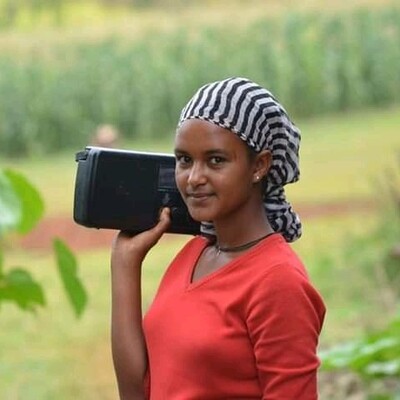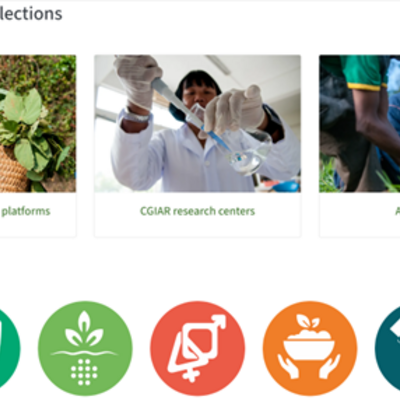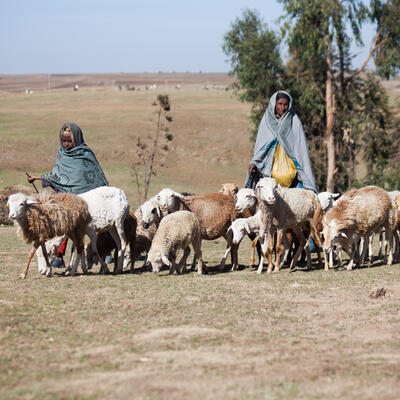
Seizing virtual opportunities for CGIAR research in a pandemic
Every cloud has a silver lining – even a pandemic. For months, while the COVID-19 crisis locked CGIAR researchers into their homes, it also unlocked virtual innovation across the whole network. Like green shoots in the sunshine, people across the CGIAR turned towards virtual tools, applications and opportunities to connect, share, collaborate, communicate and innovate.
In October 2020, in and alongside the CGIAR Big Data Platform’s virtual convention, ILRI staff facilitated several online conversations to capture, discuss and assess, and share the diverse ways the CGIAR is growing and adapting to the virtual ‘normal’.
This post summarizes a longer note, reporting on some of the trends and practices that were shared and providing some recommendations which will be useful to the OneCGIAR process going forward.
It draws from several interactions, including a conversation thread (on the Whova platform) as part of the CGIAR Big Data convention, a Zoom virtual discussion, and a chat on the Microsoft Teams platform of the CGIAR Research Program on Livestock.
Virtual research in a pandemic
Virtual readiness
Despite only some organizations having digital champions, it seems that online, digital and virtual tools were widely taken up. There was much experimentation (and stress) and probably not enough guidance on which worked best for each situation. Staff generally moved quickly, trying new tools and approaches and learning new skills.
Virtual meetings
An ‘epidemic’ of virtual meetings has swept the CGIAR and beyond. Some excellent, some terrible and everything in between. These show that actually much interaction and engagement can be done virtually – not just meetings to share and disseminate, but also brainstorming, working together and teambuilding.
Virtual meetings were said to offer benefits over face to face in terms of inclusion, reducing travel and decreasing carbon footprints, using more innovative tools, and reminding people of the need to focus on design and objectives. But they also suffer from technical and connectivity challenges. Some simply replicate the worst elements of face-to-face meetings – many power points and little discussion. The issue of relationship building was also raised. It is difficult to recreate the inter-personal dimensions that people value in face-to-face discussions. Finally, we are seeing an exhaustion due to the number of meetings creating overload and significant challenges to work--life balances.
“At the end of the day, the major goals and objectives of the meeting were not met; the majority couldn't connect, contribute or share their opinions.”– CGIAR national partner
“Many people miss the brainstorming, but through virtual spaces my experience is that large team discussions can be much more inclusive – colleagues who are often silent (or drowned out) in face-to-face meetings can interact and contribute more through virtual means” – CGIAR scientist.
Whatever the format, the pandemic has raised expectations about virtual events. It was argued that it is essential for these to be even better designed and planned. “Bad offline meetings are terrible when they are transported to the virtual environment.”
To promote better meetings, some practical lessons from running good virtual meetings were documented by ILRI staff.
Virtual surveys
Some areas of research, such as surveys, have also become virtual. Entire surveys have been conducted using phones. While recognizing the positives, scientists were concerned about the validity and reliability of such data, and such fully digital approaches require high levels of trust by the respondents. Thus, from a CGIAR scientist: “a planned survey in Kenya didn't take place as the traders were not comfortable interacting on phones … trust is everything!”
From a CGIAR national partner: “My organization is currently testing how phone interview could replace in-person surveys. I must confess, it has not been easy as majority of the farmers declined our invitation … Another limitation of this kind of survey is that we couldn't verify some of the technical information provided.”
Virtual training
Like meetings, training is being delivered virtually, often with new learning materials, sometimes blending digital delivery with face-to-face interaction. A CGIAR example illustrates how planned training went online with a YouTube channel as well as field manuals and other training materials. A CGIAR scientist: “So I expect that we will increasingly see a hybrid form, with face-to-face training and online support, where some participants are able to gather and join the remote training together.”
Elsewhere, this virtual training is extending into something closer to project supervision: “Something that was quite new is doing a whole complex soil data collection exercise (fresh soils for microbiology) in Rwanda completely virtually with just the field assistants on location. A PhD student was supposed to be on location for many weeks to do this, and now we did virtual training plus very close field follow up and video calls in the field. It worked better than I had hoped!”
One challenge, just as for physical meetings, is that many participants need to have time and permission to attend these events.
So, while virtual can seem informal, one scientist explained that “virtual workshops actually need the same level of formal invitations. We had underestimated this and saw that some participants struggled consequently to be released for the time required for the training.”
Virtual working
Some surveys and feedback indicate that virtual home working is generally productive in that staff were able to work, collaborate, manage and meet, and they could interact with partners and clients who themselves were in the same situations. A significant caveat is that such virtual home working poses work-life balance challenges, and people were concerned that social capital and relationships built over time with colleagues and partners were weakening.
A CGIAR scientist: “It is very hard to remain engaged online for more than 2 hours. National partner meeting participation is still an issue as many cannot connect. Time boundaries are less respected than before as we have virtual meetings across time zones … It is very hard for parents.” Further: “For day to day work, one of my colleagues commented that it is harder to have a work-life balance now as there is an expectation for workmates to be always connected as they work from home.” And: “I think there are significant gender issues around this work from home stuff for women.”
Virtual capital
As so many interactions become virtual, scientists were concerned about “surviving in many instances on social capital with colleagues built up over years of face-to-face interactions … The power of bonding over local beer should not be underestimated. And the lack of exposure to field realities will eventually become a problem. Endless zooms are taxing; although I don't miss the exhaustion of travel, I now realise that meeting colleagues on the road is very important for energy and creativity.”
Another scientist: “We are currently banking on the social capital we built in the past. I don't think it necessarily just maintains itself, the same with partners - you need to sometimes sit together and chat, go to the field or travel together to build and maintain the relationships that have been a key component of the added value of the CGIAR.”
Towards more effective virtual research
Reflecting on these and other experiences, a group of mainly communicators and facilitators working with CGIAR reflected on their experiences with virtual engagement and interaction. Some key observations included:
There is a widespread growth in digital and e-literacy among individuals and teams, with previously semi-used tools and platforms widely taken up and everyone learning and perfecting virtual skills and tools and trying out new ways of collaborating and meeting.
There is a growing ‘process’ literacy as people recognize that virtual events and working needs additional effort – whether to designing virtual agenda’s, setting up regular interaction and support for virtual home-workers, or integrating different forms of online interaction over time.
Virtual tools that work initially may not work in the longer term, requiring that we manage the edge between ‘cool new tool’ and ‘tool overwhelm.’ Further, as everyone has become an active champion for their favourites in the bazaar of tools, we have perhaps too much diversity and our organizations should strategically define an inclusive set of platforms and tools optimized for different collaboration needs.
They also identified some practices to enhance virtual engagement:
- Blend real-time synchronous with asynchronous communication, using a sequence of smaller, connected interventions rather than trying to do everything in one virtual session.
- Prioritize asynchronous work (e.g. collaboration tools, shared documents...) above real-time meetings. This helps to get work done regardless of working hours or time zones.
- Design for people and their capacities. Avoid being too optimistic about our abilities to 'just use' more advanced tools. Learn and test any new tools (or buy in experts) before experimenting in live situations.
- For virtual events and meetings, build out ‘technical hosting’ skills of people who typically set up and manage meeting platforms so they can help facilitate interface between technologies and process.
- Track which types of meetings, and which facilitation and collaboration tools produce the best results. Different tools serve different purposes even if they seem similar in form.
- Codify and track what’s produced and documented across meetings, platforms and discussions so they can be curated, re-used and built upon.
- Make best practices the standard: For example, a simple shift from sending document in emails to shared editable documents online.
- Find ways to deal with virtual meetings overload and find virtual ways to build back some of the informal networking and socializing that is so necessary to facilitate our work.
For a more effective virtual one CGIAR, four areas identified to take action were:
- Capitalize and standardize: Share a base set of common tools and best practices for all to use.
- Innovate and learn: Stimulate and seed-fund learning, reflection and experimentation on innovation in virtual research support.
- Share: Foster a Community of Practice that encourages ideas from the bottom up, documenting and advocating good practices, and involving people beyond the CGIAR.
- Stategize: Work towards a CGIAR digital-virtual strategy that sets out our ambitions, roles and priorities. Start with small steps, focus on clear outcomes, and draw from evidence and practice.
Post-pandemic, the new normal will most likely see a mix of old and new practices, tools and skills. To build back better, it will be essential to continue to learn and apply lessons to operate more efficiently and effectively, deliver more impactful research and, most important, enrich and enhance how we engage with partner, stakeholders and farmers to translate virtual to realistic opportunities.
Read the full notes: Virtual opportunities and challenges for CGIAR research in a pandemic

















